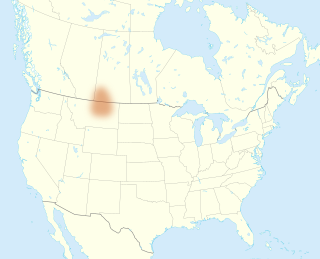| Gros Ventre | |
|---|---|
| 'ɔ'ɔ́ɔ́ɔ́naakíit'ɔ | |
| Native to | United States |
| Region | Montana |
| Ethnicity | Gros Ventre |
| Extinct | 2007, with the death of Theresa Lamebull[1] |
| Revival | 45 self-identified speakers as of 2009-2013[2] |
Algic
| |
| Official status | |
Official language in | ( |
| Language codes | |
| ISO 639-3 | ats |
| Glottolog | gros1243 |
| ELP | Gros Ventre |
 Historical extent of the language | |
 Gros Ventre is classified as Critically Endangered by the UNESCO Atlas of the World's Languages in Danger | |
Atsina, or Gros Ventre (also known as Aaniiih, Ananin, Ahahnelin, Ahe, A’ani, and ʔɔʔɔɔɔniiih),[3] was the ancestral language of the Gros Ventre people of what is today Montana, United States of America. The last fluent speaker died in 2007,[1] though revitalization efforts are underway.
YouTube Encyclopedic
-
1/5Views:2 5949891 8894 0981 663
-
Aaniiih: The Gros Ventre People - History, Culture & Affiliations - Canada & USA
-
Aaniiih Language
-
Gros Ventre
-
How To Say Gros Ventre
-
How to pronounce Gros Ventre
Transcription
History
Atsina is the name applied by specialists in Algonquian linguistics. Arapaho and Atsina are dialects of a common language usually designated by scholars as "Arapaho-Atsina". Historically, this language had five dialects, and on occasion specialists add a third dialect name to the label, resulting in the designation, "Arapaho-Atsina-Nawathinehena".[1] Compared with Arapaho proper, Gros Ventre had three additional phonemes /tʲ/, /ts/, /kʲ/, and /bʲ/, and lacked the velar fricative /x/.
Theresa Lamebull taught the language at Fort Belknap College (now Aaniiih Nakoda College), and helped develop a dictionary using the Phraselator when she was 109.[4]
As of 2012, the White Clay Immersion School at Aaniiih Nakoda College was teaching the language to 26 students, up from 11 students in 2006.[3][5]
Phonology
Consonants
| Bilabial | Dental | Alveolar | Palatal | Velar | Glottal | ||
|---|---|---|---|---|---|---|---|
| Plosive | plain | b ⟨b⟩ | t ⟨t⟩ | k ⟨k⟩ | ʔ ⟨’⟩ | ||
| palatalized | bʲ ⟨bʸ⟩ | tʲ ⟨tʸ⟩ | kʲ ⟨kʸ⟩ | ||||
| Fricative | θ ⟨3⟩ | s ⟨s⟩ | h ⟨h⟩ | ||||
| Affricate | ts ⟨c⟩ | tʃ ⟨č⟩ | |||||
| Nasal | n ⟨n⟩ | ||||||
| Approximant | w ⟨w⟩ | j ⟨y⟩ | |||||
Vowels
| Short | Long | |
|---|---|---|
| Close | ɪ ⟨i⟩ | iː ⟨ii⟩ |
| Mid | ɛ ⟨e⟩ | eː ⟨ee⟩ |
| Back | ɔ ⟨o⟩ | oː ⟨oo⟩ |
| ʊ ⟨u⟩ | uː ⟨uu⟩ |
Notes
- ^ a b c Mithun 1999, p. 336
- ^ "Detailed Languages Spoken at Home and Ability to Speak English". www.census.gov. US Census Bureau. Retrieved 2017-11-17.
- ^ a b "Immersion School is Saving a Native American Language". Indian Country Today Media Network. 2012-02-12. Archived from the original on 2012-11-09. Retrieved 2012-10-22.
- ^ "The Phraselator II". The American Magazine. Archived from the original on 2013-08-07. Retrieved 2013-05-12.
- ^ Boswell, Evelyn (2008-12-04). "MSU grads preserve a native language, keep tribal philosophies alive". MSU News Service. Archived from the original on 2013-03-03. Retrieved 2012-07-19.
- ^ Salzmann, Zdeněk (1969). Salvage Phonology of Gros Ventre (Atsina).
References
- Mithun, Marianne (1999). The languages of native North America. Cambridge Language Surveys. Cambridge, UK: Cambridge University Press. ISBN 9780521298759.
Further reading
- Malainey, Mary E. (2005). "The Gros Ventre/Fall Indians in historical and archaeological interpretation" (PDF). The Canadian Journal of Native Studies. Brandon, MB: Brandon University. 25 (1): 155–183. Retrieved 22 July 2022.
- Capriccioso, Rob (9 October 2007). "The Phraselator II". The American Magazine. American Enterprise Institute. Archived from the original on 7 August 2013. Retrieved 23 July 2022.
- Hays Public School; Lodge Pole Public School (1980). A Basic Guide in Tri-Lingual Education in Gros Ventre and Assiniboine (PDF). Hays, MT: United States Department of Education. ERIC ED324172. Retrieved 23 July 2022.
External links
- Native Languages of the Americas: Gros Ventre (Ahe, Ahahnelin, Aane, Atsina)
- Gros Ventre Language Word Sets, Fort Belknap College
- Gros Ventre Dictionary
- OLAC Record entry for Gros Ventre
